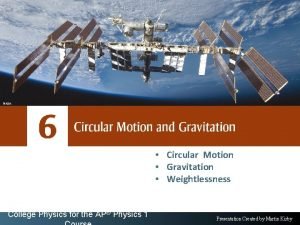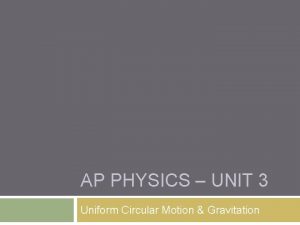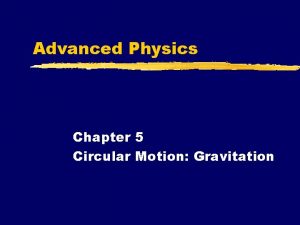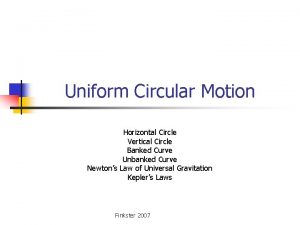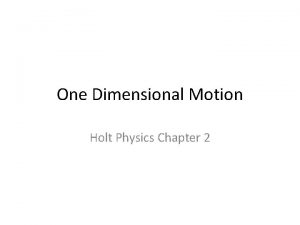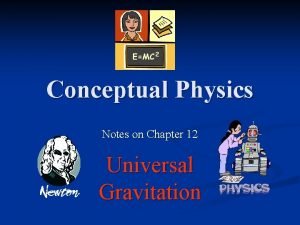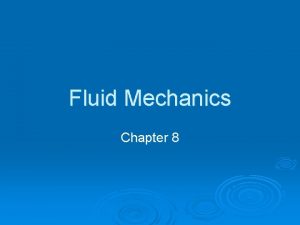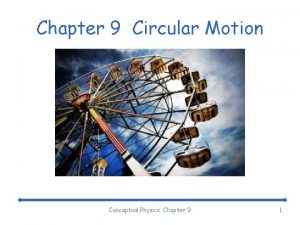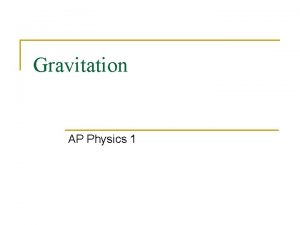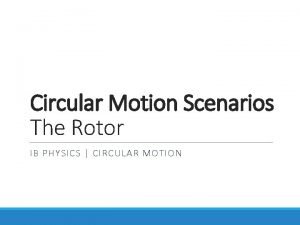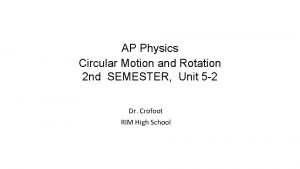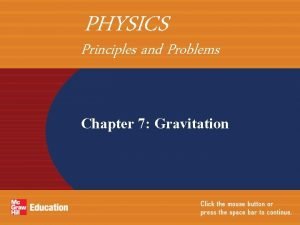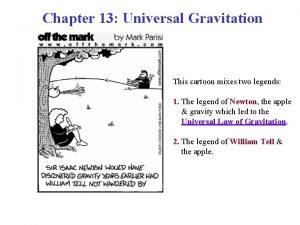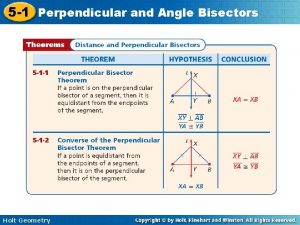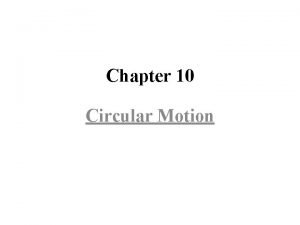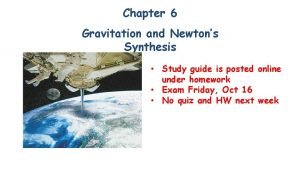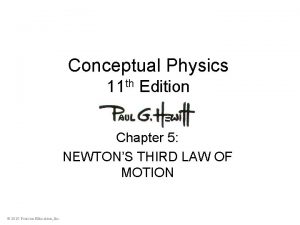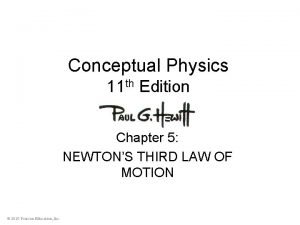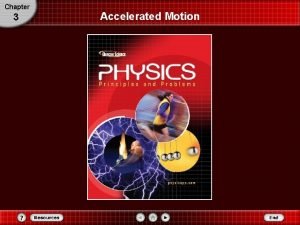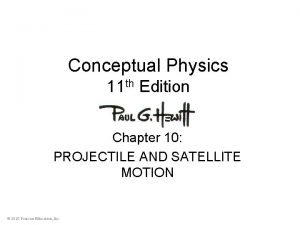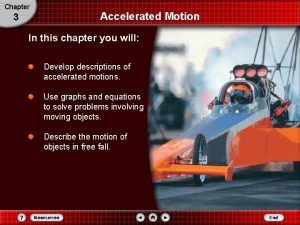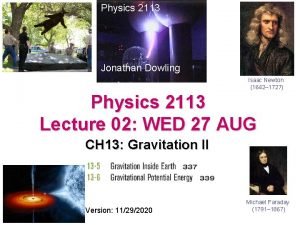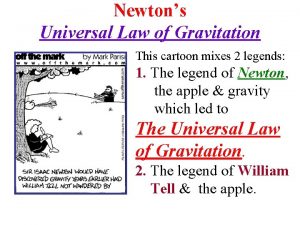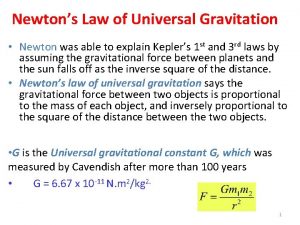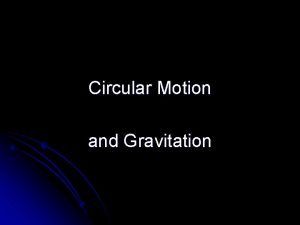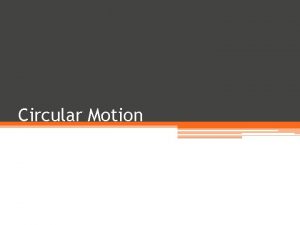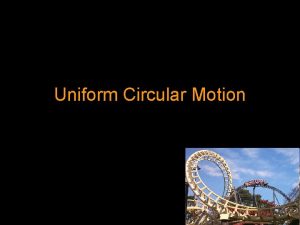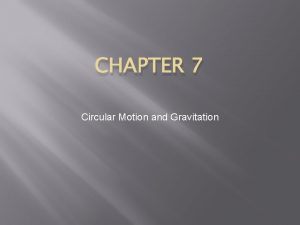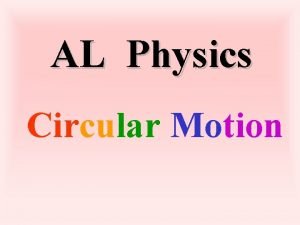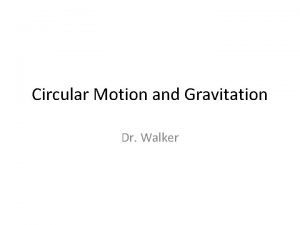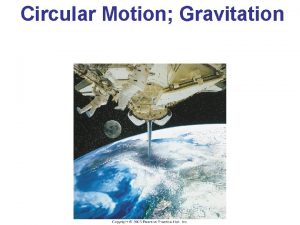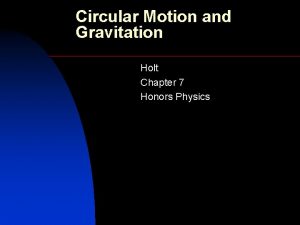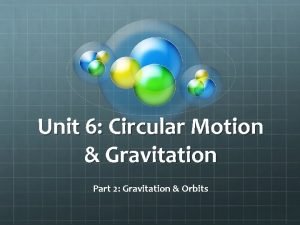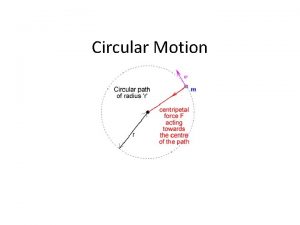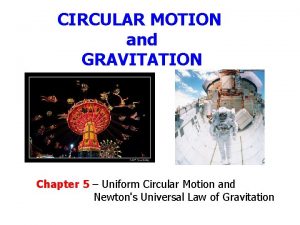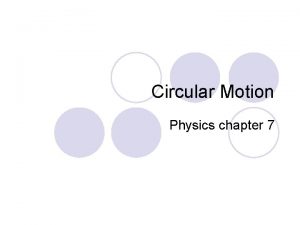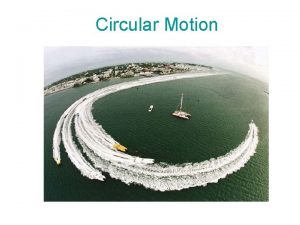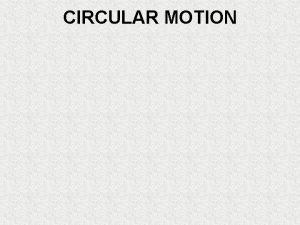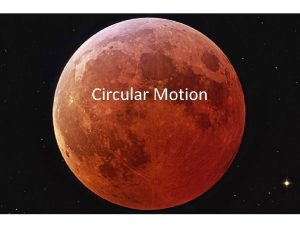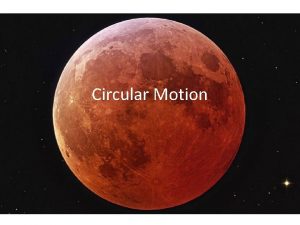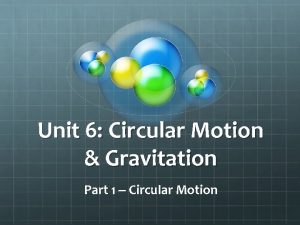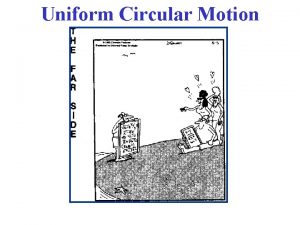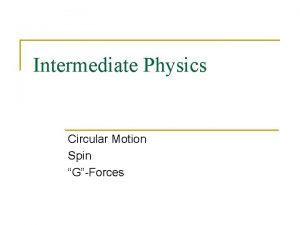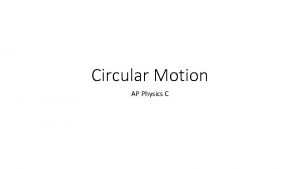Circular Motion and Gravitation Holt Physics Chapter 7


































- Slides: 34

Circular Motion and Gravitation Holt Physics Chapter 7

Centripetal Acceleration • Circular motion: motion of an object that revolves about an axis of rotation


Tangential Velocity • Velocity (vt) of an object directed along a line tangent to its circular path • What would uniform circular motion mean?

vt depends upon radius • Object B must travel a greater distance to keep up with object A • SB > SA • But Δt. B = Δt. A • Therefore, v. B > v. A

Centripetal Acceleration • Velocity is a vector (magnitude & direction) • Acceleration is a change in velocity • An object with constant speed, but changing direction, is accelerating • Acceleration of an object with uniform circular motion (constant vt) has centripetal acceleration

Centripetal Acceleration • a = Δv/Δt • When subtracting vectors, reverse the direction of vi • Centripetal acceleration is, therefore, directed toward the center (axis of rotation)

Centripetal Acceleration • Centripetal means “center seeking” and is always directed toward the center • Due to a change in direction of vt

Centripetal Force Because Fc acts at right angles to the object’s circular motion, it changes the direction of the objects velocity

Centripetal Force • Is the cause of centripetal acceleration • It is directed toward the axis of rotation • It is the net force acting on an object in uniform circular motion, i. e. it is the cause of circular motion • Newton’s second law applies • Fc=mac • Since ac = vt 2/r • Fc=mvt 2/r • Centrifugal force is a misunderstanding of inertia

Centripetal vs. Centifugal Force • Centrifugal force is not real • It is an “apparent” force due to a misinterpretation of inertia

Newton’s Universal Law of Gravitation • Gravitational Force – Mutual force of attraction between particles of matter – Gravitational force is a very weak force – Weakest of the 4 fundamental forces – is proportional to the masses of the objects and inversely proportional to the square of the distance between their centers.

Newton’s Universal Law of Gravitation Fg is gravitational force G is constant of universal gravitation; G = 6. 673 x 10 -11 N∙m 2/kg 2 (by Cavendish) Cavendish m 1 m 2 are masses of the two bodies r is distance between centers of masses

Newton’s Universal Law of Gravitation Newton’s Mountain Newton’s Thought Experiment A cannonball fired from sufficient height with sufficient velocity will orbit the earth. Objects in orbit are in continuous free fall They do not hit the earth because the earth curves away from the object • • http: //spaceplace. nasa. gov/en/kids/orbits 1. shtml http: //galileoandeinstein. physics. virginia. edu/more_stuff/Applets/newt/ne wtmtn. html

Gravitational Field • Gravity is a field force • Gravitational Field • Field strength varies with distance from Earth’s center • Is described by g, – i. e. the value of g describes the strength of the gravitational field at a particular location in the field

Weight Changes with Location • Because gravitational field strength varies, ag varies (acceleration of gravity). • Since w = mag, weight must vary as ag varies • Fg is an example of an inverse square law

7. 3 Motion in Space Astronomer Ptolomey Planets orbit… Earth Type of orbit Epicycles Copernicus Sun Circular Kepler Sun Elliptical

Kepler’s Laws of Planetary Motion 1. The Law of Orbits: All planets move in elliptical orbits, with the sun at one focus. 2. The Law of Areas: A line that connects a planet to the sun sweeps out equal areas in equal times. 3. The Law of Periods: The square of the period of any planet is proportional to the cube of the average distance from the sun,

Kepler’s Second Law: The Law of Areas • A line that connects a planet to the sun sweeps equal areas in equal times • Since the arc A 1 > A 2 but Δt 1 = Δt 2 • The speed of the planet is greater when it is closer to the sun

Kepler’s 3 rd Law Describes Orbital Period

Weight & Weightlessness • A bathroom scale reads the normal force of the scale acting on your feet • Under normal conditions this equals your weight • Suppose you stand on a scale… • If someone were to push down on your shoulders, how would the normal force change? • What if someone lifted you up somewhat?

• What if the scale was in an elevator? • What happens when the elevator begins to go up? • What happens when it begins to go down? • What would the scale read if the elevator was in free fall?

• • In these situations, did your mass change? Did the scale readings change? So, did your true weight change? What did change was your apparent weight

Apparent Weight

Torque • a quantity that measures the ability of a force to rotate an object about an axis • is not a force • “turning ability” • the product of force and “lever arm” • τ = F · d sinθ • Lever arm (d) is distance perpendicular to direction of force to axis of rotation


Torque • Sign (+) is counterclockwise (-) is clockwise • Net Torque when 2 or more forces act to rotate the same object, τnet = Στ τnet = τ1 + τ2 = F 1 d 1 + F 2 d 2

Torque Equilibrium • Sum of torques = 0 • ∑τ = 0; τ clockwise = τcounterclockwise • An object is in “balance” like a teeter-totter

Mobiles • Are applications of torque equilibrium

Simple Machines • All machines are combinations of simple machines • Purpose is to change magnitude or direction of an input force • Mechanical Advantage describes the ratio of output and input forces

Ideal vs. Actual Mechanical Advantage • Ideal MA MA if there were no friction d = lever arm • Actual MA MA that takes friction into account

Machines and Work • Machines do not change the amount of work • Machines make work easier

Efficiency • A measure of how well a machine works • A less efficient machine produces less output per input • A less efficient machine requires more input to get the same output

Six Simple Machines • • • Lever Inclined Plane Wheel & axle Pulley Wedge Screw
 Circulatory motion
Circulatory motion Ap physics unit 3 circular motion and gravitation
Ap physics unit 3 circular motion and gravitation Chapter 5 circular motion gravitation
Chapter 5 circular motion gravitation ? = 4?²?³/??²
? = 4?²?³/??² The sears tower in chicago is 443 m tall. suppose a book
The sears tower in chicago is 443 m tall. suppose a book Conceptual physics chapter 13 universal gravitation
Conceptual physics chapter 13 universal gravitation Holt physics chapter 16 test
Holt physics chapter 16 test Buoyancy force in fluid mechanics
Buoyancy force in fluid mechanics Conceptual physics chapter 9 circular motion answers
Conceptual physics chapter 9 circular motion answers Newton's universal law of gravitation ap physics 1
Newton's universal law of gravitation ap physics 1 Ib physics
Ib physics Ap physics circular motion
Ap physics circular motion Chapter 7 study guide gravitation
Chapter 7 study guide gravitation Cartoon law of universal gravitation
Cartoon law of universal gravitation 5-3 perpendicular and angle bisectors
5-3 perpendicular and angle bisectors Chapter 10 circular motion
Chapter 10 circular motion Gravitation and newton's synthesis
Gravitation and newton's synthesis Hobbs and holt 1976
Hobbs and holt 1976 Token economy in prisons examples
Token economy in prisons examples Conceptual physics chapter 5 newton's third law of motion
Conceptual physics chapter 5 newton's third law of motion Conceptual physics chapter 5 newton's third law of motion
Conceptual physics chapter 5 newton's third law of motion Conceptual physics chapter 3 linear motion
Conceptual physics chapter 3 linear motion Chapter 3 accelerated motion answers
Chapter 3 accelerated motion answers Chapter 2 physics test prep representing motion
Chapter 2 physics test prep representing motion Chapter 10 projectile and satellite motion
Chapter 10 projectile and satellite motion Accelerated motion chapter 3 answers
Accelerated motion chapter 3 answers parallel lines in a hairstyle:
parallel lines in a hairstyle: Chapter 2 section 1 describing motion answer key
Chapter 2 section 1 describing motion answer key Describing and measuring motion
Describing and measuring motion Section 1 describing motion
Section 1 describing motion Explain newton’s universal law of attraction/gravitation.
Explain newton’s universal law of attraction/gravitation. Gauss theorem
Gauss theorem Newton's third law cartoon
Newton's third law cartoon Fg physics formula
Fg physics formula Newton's law of gravitation
Newton's law of gravitation
